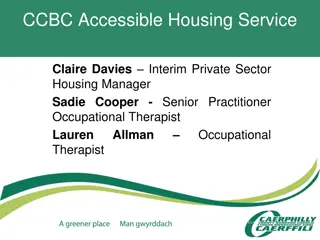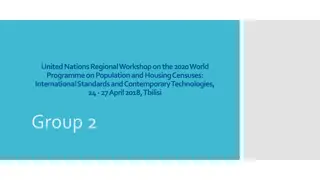Impacts of COVID-19 on Population and Housing Censuses: Challenges and Solutions
The COVID-19 pandemic has disrupted the implementation of population and housing censuses worldwide, leading many countries to postpone or modify their census operations. National Statistical Offices faced challenges in conducting traditional field-based censuses as scheduled in 2020 and 2021. The UN Statistics Division organized Expert Group Meetings to assess the impact and discuss alternative solutions, including modifications in census procedures to minimize direct contact and introduce new data collection methods such as CAWI, CATI, and paper-based self-enumeration.
Uploaded on Nov 12, 2024 | 3 Views
Download Presentation

Please find below an Image/Link to download the presentation.
The content on the website is provided AS IS for your information and personal use only. It may not be sold, licensed, or shared on other websites without obtaining consent from the author.If you encounter any issues during the download, it is possible that the publisher has removed the file from their server.
You are allowed to download the files provided on this website for personal or commercial use, subject to the condition that they are used lawfully. All files are the property of their respective owners.
The content on the website is provided AS IS for your information and personal use only. It may not be sold, licensed, or shared on other websites without obtaining consent from the author.
E N D
Presentation Transcript
Impacts of the Covid-19 pandemic on Conducting Population and Housing Censuses UN Statistics Division Statistics Division Demographic and Social Statistics Branch Demographic Statistics Section
Introduction Implementation of the 2020 round of population and housing censuses has been significantly disrupted by the arrival of the Covid-19 pandemic. National Statistical Offices (NSOs) have been challenged in their attempt to conduct their census as scheduled in 2020 and 2021 to the extent that many countries that undertake a traditional census or combined census involving a large-scale field-based data collection operation have had to postpone their censuses for more than a year. UNSD, as part of its activities to monitor the state of the census taking, has conducted two Expert Group Meetings in February and November 2021 in order to assess the adverse impact of the COVID- 19 pandemic on the implementation of the 2020 World Programme on Population and Housing Censuses. Statistics Division Demographic and Social Statistics Branch Demographic Statistics Section
UN Expert Group Meetings on the impact of the Covid-19 pandemic More than 100 experts from over forty national statistical offices, regional and international organizations participated to each EGM First EGM on 9-12 February 2021 Second EGM on 2-5 November 2021 Main objectives are: Monitor and document challenges in conducting censuses during the pandemic Discuss alternative solutions in designing census operations for producing relevant, timely and reliable statistics Discuss the effects of the pandemic on data quality and census measurements Forty-five country presentations https://unstats.un.org/unsd/demographic- social/meetings/2021/egm-covid19-census.cshtml https://unstats.un.org/unsd/demographic- social/meetings/2021/egm-covid19-census2/ Statistics Division Demographic and Social Statistics Branch Demographic Statistics Section
Main conclusions and recommendations (1) Modifications in census procedures Many countries are facing challenges in conducting population and housing censuses as scheduled in 2020 or 2021 Countries that planned to conduct their censuses in 2020 or 2021 with the traditional or combined census methodology had to either postpone census activities or to extend the enumeration period Countries relying only on administrative registers for producing census statistics are also facing challenges with regard to receiving administrative records timely during the pandemic time. This may cause delays in dissemination of censuses results as scheduled Majority of countries had to modify census procedures in response to the impact of the COVID-19 pandemic, particularly to reduce direct contact with respondents Main modifications in census procedures are related to introducing new data collection modes (computer assisted web interview (CAWI), computer assisted telephone interview (CATI) and paper- based self-enumeration (drop off-pick up) for replacing face-to-face interviews Statistics Division Demographic and Social Statistics Branch Demographic Statistics Section
Main conclusions and recommendations (2) Modifications in census procedures The meeting recommended that before adjustments are made to the design of the enumeration modes, sufficient time be allocated for testing new processes, applications and systems testing the adequacy of the integration of the data collection systems is especially important to meet the operational challenges of managing multi-mode data collections Statistics Division Demographic and Social Statistics Branch Demographic Statistics Section
Main conclusions and recommendations (3) Modifications in census procedures In addition to the adjustments of data collection procedures, census-taking during the pandemic resulted in introduction of other actions such as: Additional budget for: procurement of personal protective equipment (PPEs) for field staff; enhanced publicity campaign to inform public, increase awareness and safety about COVID- 19, educate the population on new modes of data collection, etc.; Revising census law to extend the time and duration of census and reflect changes in data collection methods; Continuous coordination with health authorities to enhance safety protocols to mitigate against the spread of COVID-19; Producing guidelines on how to prevent/mitigate COVID-19 during field operations; and, train field staff; Developing special procedures for areas under lock-down or designated as red zones, and for institutional households; Providing online training for field staff; and, where training is not online, training in small groups Statistics Division Demographic and Social Statistics Branch Demographic Statistics Section
Main conclusions and recommendations (4) Possible adjustments in census questionnaire and additional guidance to respondents The census provides a snapshot in time and therefore the consistent message for respondents should be to answer the questions about their current circumstances For a limited number of questions, for example, questions on hours worked, and travel to work where the respondent is currently away from work on furlough, respondents might be advised to answer these questions based on their situation immediately before the current period away from work The topics where the coronavirus pandemic could potentially affect response, either through a change in circumstances, or because of a change in interpretation and understanding, may include: those who usually live in the household, visitors, migration, economic activity, occupation, industry, hours worked and travel to work It is recommended that additional guidance to explain how to answer specific questions should be provided to self-respondents comprehensive testing is required before making any changes Statistics Division Demographic and Social Statistics Branch Demographic Statistics Section
Main conclusions and recommendations (5) Possible adjustments in census questionnaire Collecting information on exact date of events for certain census topics (deaths, births, and migration) rather than asking questions about the occurrence of events during a reference period is advantageous in terms of analyzing the changes in the level and pattern of such events during the pandemic- particularly for countries that do not have reliable registers for such events For example, when the question on household deaths (recommended core census topic for the 2020 round of censuses) is included in the questionnaire, the information on date of deaths in addition to age and sex of deceased persons should be collected and a reference date covering a 12-month or longer period should be used. Statistics Division Demographic and Social Statistics Branch Demographic Statistics Section
Main conclusions and recommendations (6) Impact on population count The concept of usual residence may prove ambiguous for certain population groups such as: people who moved several times during the pandemic, students who usually live away from their family home but staying with their family during the pandemic persons living in residential care facilities for older persons workers who had to move back to their family house from their place of usual residence because of the COVID-19 lockdowns Simplified procedures focusing on the provision of a minimum set of data, the use of administrative data and increasing the time available for counting homeless persons and people living in residential care facilities could be considered for improving the census coverage In addition, there might be a significant undercount if face-to-face interview has not been offered to certain population groups such as indigenous people, homeless persons, people living in remote or rural areas. Statistics Division Demographic and Social Statistics Branch Demographic Statistics Section
Main conclusions and recommendations (7) Higher costs due to modifications in census procedures One of the major impacts of the COVID-19 pandemic on census-taking is an increased cost in the majority of countries Postponing enumeration activities implied that the costs of field staff and storing census materials and devices would be much higher than initially planned for. Adoption at a later stage of new data collection modes, including those that do not require direct contact with respondents, increased the census budget beyond that originally planned. In addition to the modifications in data collection procedures, census-taking during the pandemic increased the costs due to additional measures to minimize the adverse impact of the COVID-19 pandemic such as o the procurement of personal protective equipment (PPEs) for field staff, o organizing online training to the field staff o enhanced publicity campaigns to inform the public o educate the field staff on new modes of data collection o telecommunication for telephone interviews and data for mobile devices Statistics Division Demographic and Social Statistics Branch Demographic Statistics Section
Main conclusions and recommendations (8) Quality assessment Conducting field enumeration under the pressure of the Covid-19 pandemic has created concerns in terms of data quality, particularly under-counting of population-such as institutional population and homeless; Administrative records, event if not universal but relatively of good quality in some areas of a country are considered as an alternative source for improving census coverage and adjustment of population count for non-responding households; Well-designed quality assessment for enumeration and data processing is crucial to ensure high quality of data: assessing the quality of data in terms of coverage and content error should be undertaken using independent data sources, such as post enumeration surveys and comparing with administrative sources quality indicators such as coverage error and item non-response and imputation rate at variable level should be produced suggested that the results of quality assessment and quality indicators should be publicly available to inform users about the quality of data Statistics Division Demographic and Social Statistics Branch Demographic Statistics Section
Main conclusions and recommendations (9) Concerns on comparability of census data over time The pandemic circumstances, including mobility restrictions within the country and between countries, would have a significant influence on population distribution, the level of fertility, mortality and internal and international migration, employment, and unemployment rates affect time series and may create challenges in comparing the 2020 round of censuses with previous census results Similarly, changes in census procedures, particularly increases in online responses would improve data quality but can potentially cause some breaks in the time series Censuses conducted during the COVID-19 pandemic could potentially reveal trends, changes and patterns in society not seen in previous census results- although to what extent those trends/changes would be significant are yet to be seen. Such new trends, changes and patterns will have implications for census data comparability over time Statistics Division Demographic and Social Statistics Branch Demographic Statistics Section
Main conclusions and recommendations (10) Communication with users Before releasing census data, it would be of paramount importance to contextualize the findings from the census by contrasting them with recent data and analysis from other sources Communication with stakeholders and data users is extremely important when it comes to data analysis and release of censuses conducted during the COVID19 pandemic Engaging with stakeholders and data users ahead of data releases, especially on census subject matter areas more impacted by the collection of the data during the pandemic, is key to managing the expectations of data users and explaining trends, changes and patterns not seen in previous census results and in other statistical data collections Statistics Division Demographic and Social Statistics Branch Demographic Statistics Section























